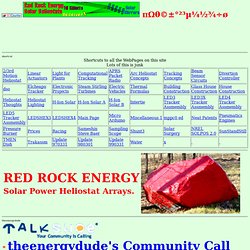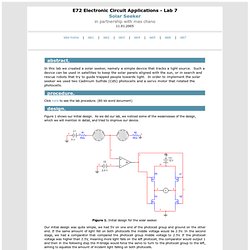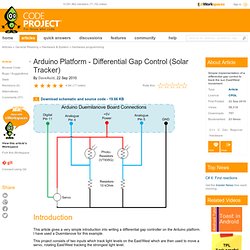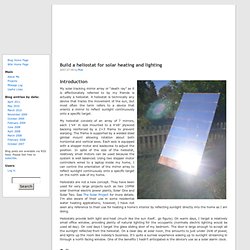

Solar Tracker. The SunSwitch sensor is basically an array of LEDs arranged on a curved surface. The sensor array is divided into an east and west array and separated by a vane which cast a shadow. When LEDs are exposed to direct sunlight within their focus angle they produce a small current (micro-amps) and associated voltage which is compatible with TTL inputs. Tracking - the shadow vane and first row of west LEDs are used for tracking.
The shadow alternately covers then exposes the first row of west LEDs. When the first row is exposed to the sun it outputs a small voltage... which turns on a DC motor via a TTL circuit which drives the tracker and sensor in a west direction casting a shadow over the first row of west LEDs causing the voltage to drop and turning off the DC motor. Searching - when resetting in the morning or updating after a cloudy period all the rows of LEDs are used and the end result is a tracking condition as above. BuildItSolar: Solar energy projects for Do It Yourselfers to save money and reduce pollution. Red Rock Energy Heliostats. πΩθ©±°²³µ¼½¾÷ø shortcut theenergydude forsale 2/3 Motion Heliostat 3M SMF1100 Solar Film Acro Solar The Acronym Finder Air Analemma APRS Arc Heliostat Arizona Solar Center American Solar Energy Society Ben Wiens Bizarre Stuff Borealis Keith Burnett Calculators CampaTracka Cell Si Co Cerebral Meltdown Chace CiraLight ClearDome Solar CLFR Colon Concepts Cooker CRACKED CREST Currency Definitions Rich DeMartile Dew Point Dish DNP Group DSIRE Ecomall Edit+ EGIS El Cheapo Electronic Goldmine Electronics Electronics Lab Energy Warrior EV Event Flight Simulator For Sale Focal Length Formulae Four Solar Free Energy Fun Science Gallery Leo Gerst Greenpeace & PV Heat Engine Heliostats Helio Track H-Ion Home Heliostat HomePower Magazine HotBot Philip J.

Hurley HyperPhysics Ingrams Jade Mountaim Junk Science Richard J. I Last edited this page on 20140115 Alternative energy systems for the home or small property owner who is interested in Natural Energy or Solar Power. searchSearch engines archimedes. e72 . lab 7 : Solar Seeker. In this lab we created a solar seeker, namely a simple device that tracks a light source.

Such a device can be used in satellites to keep the solar panels aligned with the sun, or in search and rescue robots that try to guide trapped people towards light. In order to implement the solar seeker we used two Cadmium Sulfide (CdS) photocells and a servo motor that rotated the photocells. Figure 1 shows our initial design. As we did our lab, we noticed some of the weaknesses of the design, which we will mention in detail, and tried to improve our device.
Figure 1. Our initial design was quite simple, we had 5V on one end of the photocell group and ground on the other end. Essentially, we were on the right track but we had some technical problems in our design 1- As it is, the servo motors would always turn full force! 2- The comparator typically outputs about 3.5V, but we would like to be able to have higher voltages around 12. Figure 2. Arduino Platform - Differential Gap Control (Solar Tracker) Download schematic and source code - 19.66 KB Introduction This article gives a very simple introduction into writing a differential gap controller on the Arduino platform.

I have used a Duemilanove for this example. This project consists of two inputs which track light levels on the East/West which are then used to move a servo, rotating East/West tracking the strongest light level. The crude prototype in all its glory......the surplus MSDN discs have found a use at last: Build a heliostat for solar heating and lighting. Introduction My solar tracking mirror array or “death ray” as it is affectionately referred to by my friends is actually a heliostat.

A heliostat is technically any device that tracks the movement of the sun, but most often the term refers to a device that orients a mirror to reflect sunlight continuously onto a specific target. My heliostat consists of an array of 7 mirrors, each 1′x4′ in size mounted to a 4′x8′ plywood backing reinforced by a 2×3 frame to prevent warping.
The frame is supported by a welded steel gimbal mount allowing rotation about both horizontal and vertical axes. Each axis is equipped with a stepper motor and leadscrew to adjust the position. Super Simple Sun Tracker. - Jose Pino's Projects and Tidbits. I Got some solar cells since two months ago, but it wasn't until the last week I decided to put those solar cells to work.
I really didn't have any good idea for it, I was thinking to use it to power toys or some homemade projects. Finally, I thought I can use those solar cells to charge rechargeable batteries. Bad idea. Rechargeable batteries needs from 8 to 14 hours to get fully charged but using the solar cells in a fixed position, it only gets about 6 or 7 hours of direct sunlight.
The solution: A sun tracker. A sun tracker allows to get 9 to 12 hours of direct sunlight, enough to charge some batteries. Here are the parts needed: A motor. I did use some LEGO block and gears because it was handy. The main gear is fixed to the base. This is my design of the mechanism. Sun tracking circuit for solar arrays. SunReign Reference: Solar Trackers and Heliostats. How to use photocells, LDRs, CdS cells, photoresistors! Solar Tracker.